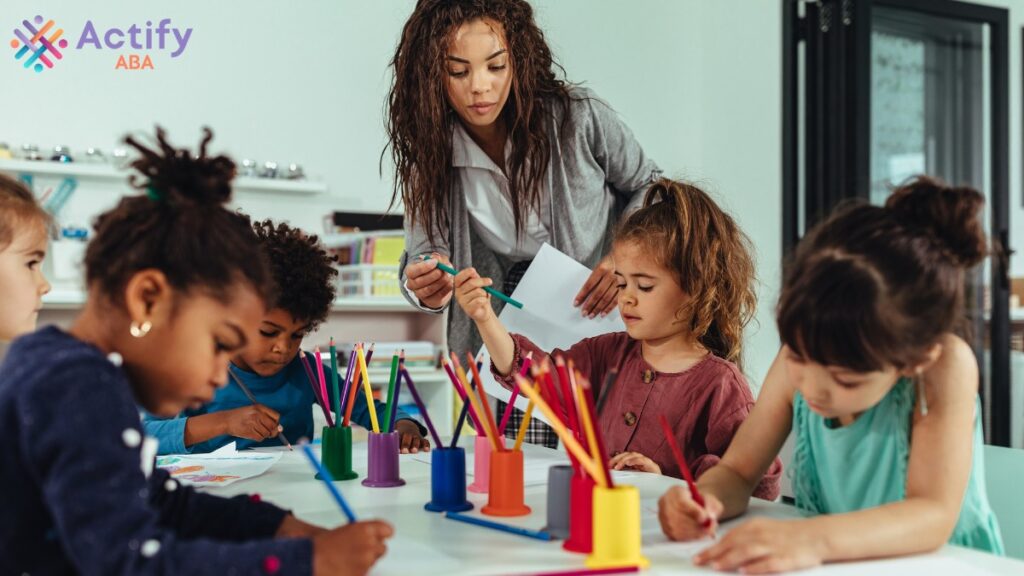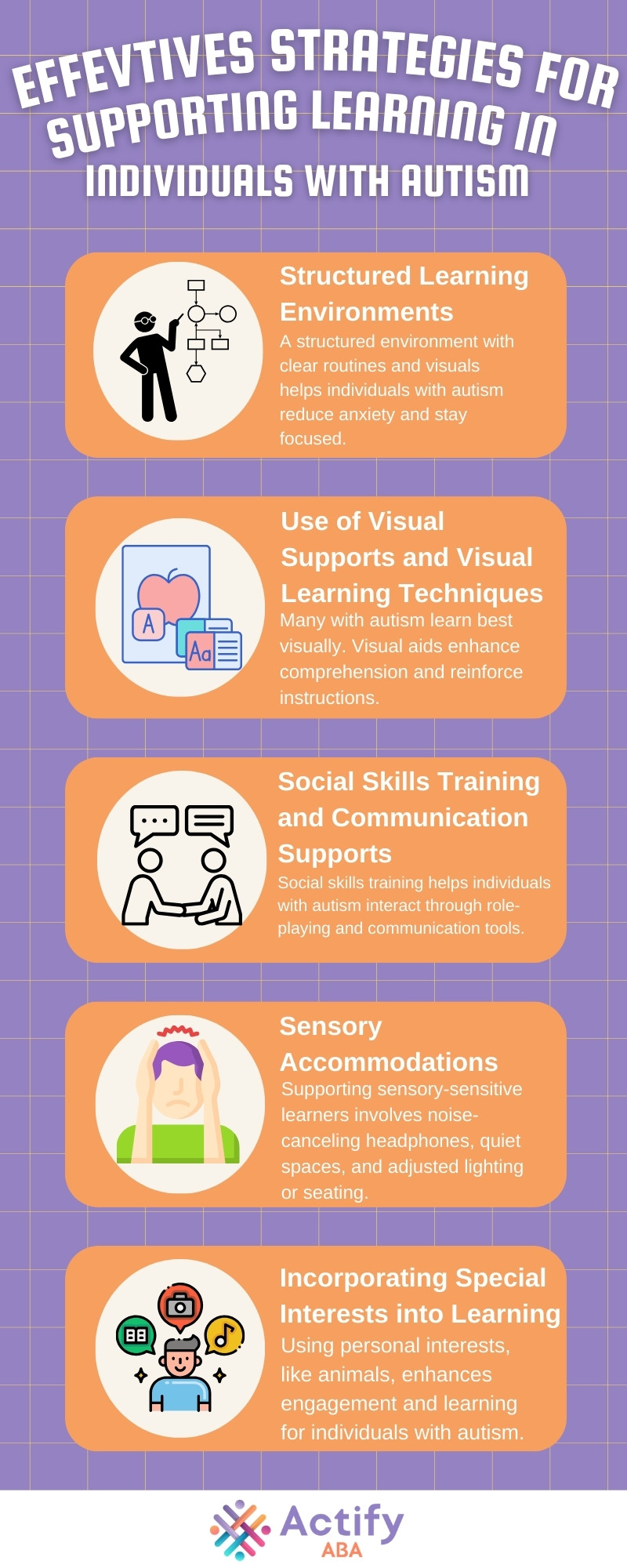
Key Points:
- Autism affects learning in various ways, from challenges in social interaction to difficulties with sensory processing, which can impact academic performance.
- Learning strategies for individuals with autism should be tailored to their specific needs, with a focus on clear, structured environments and interventions.
- Applied Behavior Analysis (ABA) therapy is one of the most effective approaches to supporting learning in individuals with autism.
When it comes to learning and autism, the unique ways in which children and adults on the spectrum process information can significantly impact how they learn, engage, and interact with the world around them. According to research, approximately 60 to 70% of autistic individuals experience some form of learning disability.
This can include challenges with communication, social interactions, and a heightened sensitivity to sensory input. As a result, autism can affect learning in profound ways, making it important to understand these challenges in order to support those affected in their learning journeys.
The good news is that with the right strategies and support, individuals with autism can thrive academically and socially. In this article, we’ll explore how autism affects learning, the key challenges it presents, and effective strategies that can make a positive difference.
How Does Autism Impact Learning?
Autism affects learning in unique ways, as individuals on the spectrum often process information differently than their neurotypical peers. These differences can shape the way they approach tasks, understand concepts, and engage with the world around them. Below are some examples of the ways autism can impact learning:

Learning Styles and Cognitive Differences
One of the key ways autism affects learning is through the individual’s cognitive processing style. Many individuals with autism may struggle with abstract thinking, which makes it harder for them to grasp concepts that don’t have a clear or tangible basis.
For example, someone with autism may excel in rote memory tasks or visual learning, but they may find it more difficult to understand concepts like metaphors, sarcasm, or abstract ideas. Additionally, individuals on the autism spectrum often have very focused interests, and their learning may be particularly strong in those areas.
For instance, a child with autism who is passionate about trains may be able to recall and understand vast amounts of information about trains but struggle with subjects that do not engage their specific interests.
Sensory Processing Issues
Many individuals with autism experience sensory processing issues, meaning they may have heightened or diminished responses to sensory stimuli. These sensory sensitivities can significantly impact their ability to focus and learn in traditional educational settings.
For example, bright lights, loud noises, or even certain textures can be overwhelming for someone with autism, making it difficult to concentrate on tasks or engage in group activities.
These sensory sensitivities can cause frustration, anxiety, and behavioral challenges in the classroom, further complicating the learning process. As such, creating an environment that minimizes sensory distractions and supports sensory regulation can help these individuals succeed in their learning.
What Are the Common Learning Challenges for Individuals with Autism?
Individuals with autism can face various challenges when it comes to learning, and these challenges can differ widely depending on the individual’s unique profile and level of functioning. Below are some of the common learning challenges faced by individuals on the spectrum:
1. Difficulty with Communication
Communication difficulties are often one of the most significant barriers to learning for those with autism. This can include both verbal and non-verbal communication. While some individuals may have delayed speech or language development, others may struggle with understanding and using language in social situations. This communication gap can make it hard for individuals with autism to express their needs, ask questions, or engage in academic discussions.
2. Social Interaction Challenges
Social difficulties are another common feature of autism, which can impact learning in group settings. Individuals with autism may have trouble understanding social cues, such as body language or tone of voice, which can make it challenging to collaborate with peers or follow classroom dynamics. They might also find it difficult to participate in group discussions or understand the unwritten rules of social interaction, which could lead to feelings of isolation.
3. Sensory Sensitivities
As mentioned earlier, sensory processing issues are common in autism. This heightened sensitivity to sensory input can result in sensory overload, which may affect the individual’s ability to focus and engage in tasks. Even something as simple as the hum of a fluorescent light or the feel of a particular fabric can disrupt the learning process. Sensory overload can lead to anxiety, meltdowns, or withdrawal, which further complicates learning.
4. Rigidity and Difficulty with Change
Many individuals with autism prefer routine and predictability. Unexpected changes in the schedule, environment, or tasks can cause distress and disrupt the learning process. This rigidity can make it difficult for them to adapt to new teaching methods or shifting classroom activities. The need for structure and routine is essential for many individuals with autism to feel secure and focus on their learning.

How Can ABA Therapy Help with Learning and Autism?
ABA therapy (Applied Behavior Analysis) is one example of an effective therapeutic approach for individuals with autism. ABA therapy focuses on teaching new skills, reinforcing positive behaviors, and reducing challenging behaviors by breaking down complex tasks into smaller, manageable steps.
ABA can support learning in various areas, including communication, social skills, academic tasks, and daily living skills. Through structured teaching methods and consistent reinforcement, ABA helps individuals with autism build skills that can enhance their ability to learn and succeed in both academic and social settings.
Here are some ways ABA therapy can enhance learning for individuals with autism:
- Improves Communication: ABA helps individuals develop functional communication skills, from basic language to more complex conversational abilities.
- Teaches Social Skills: Through role-playing and reinforcement, ABA supports the development of appropriate social behaviors, such as making eye contact or understanding social cues.
- Enhances Academic Skills: ABA techniques can break down academic tasks into smaller, manageable steps, making learning more accessible and successful for children with autism.
- Builds Daily Living Skills: ABA therapy also focuses on teaching essential daily life skills, such as personal hygiene, dressing, and meal preparation, promoting independence.
- Reduces Challenging Behaviors: ABA works on identifying the triggers for challenging behaviors and replacing them with more appropriate responses, making it easier for individuals to engage in learning.
By providing structured and individualized interventions, ABA therapy helps individuals with autism gain the skills necessary to thrive both academically and socially.
ABA Therapy in Maryland – Supporting Learning and Development
At Actify, we understand that learning and autism go hand-in-hand, and we are here to support individuals in Maryland with tailored ABA therapy programs. Whether your child is struggling with communication social skills, or adapting to changes in routine, our team of professionals is dedicated to providing individualized support that fosters growth and success.
Reach out today to learn how ABA therapy in Maryland can help your child unlock their potential and thrive in their learning journey.
